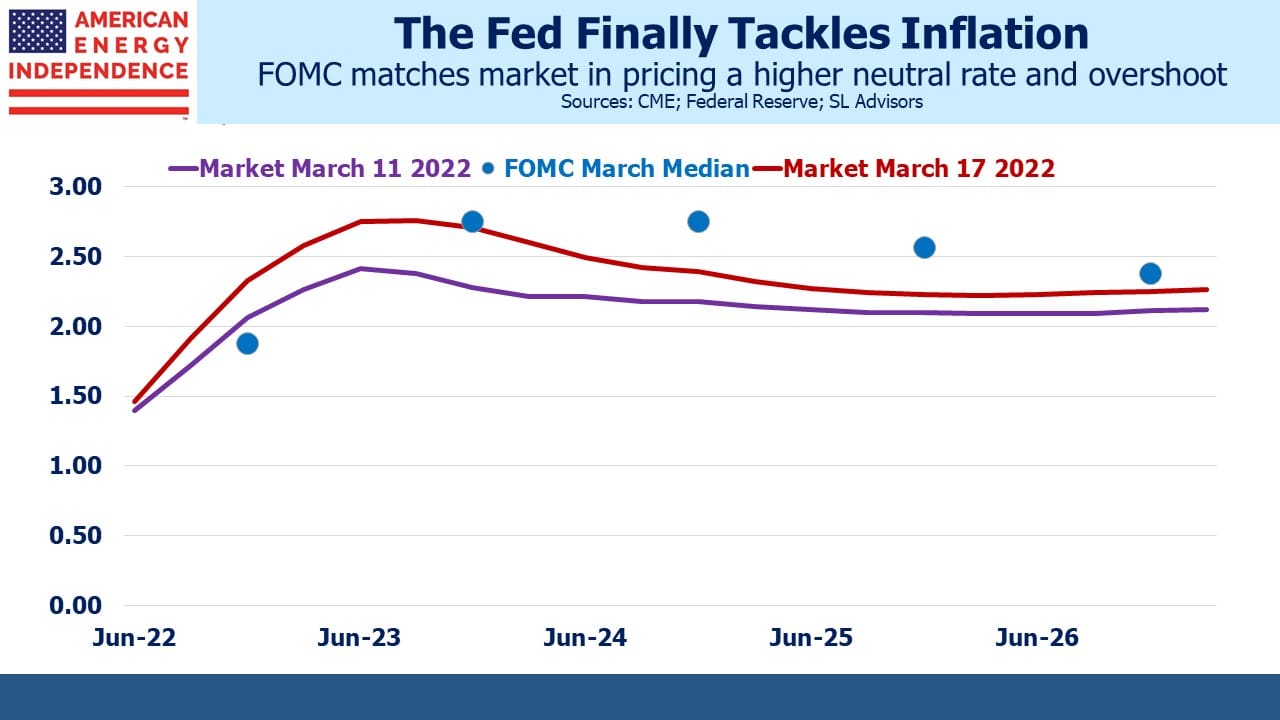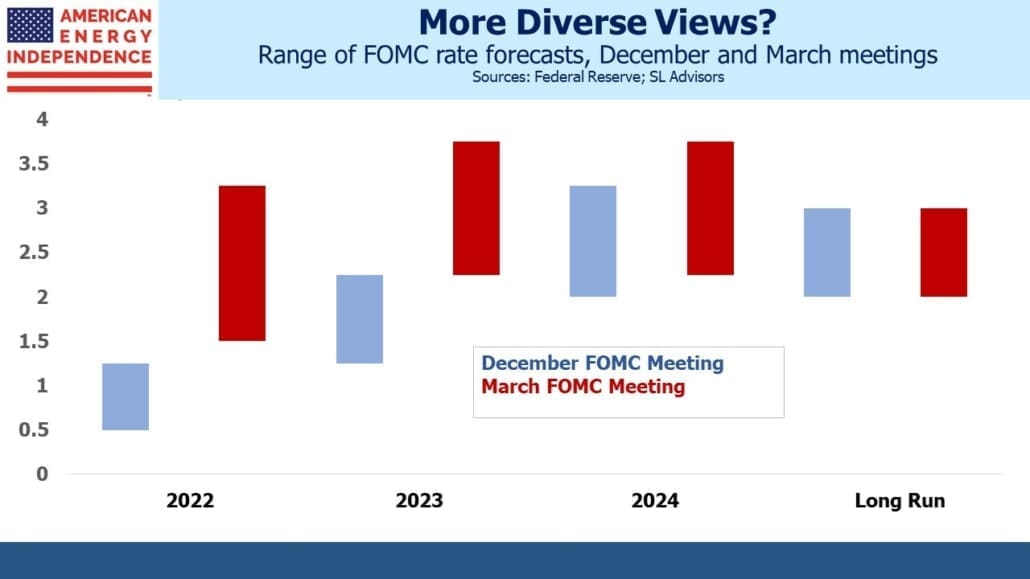Interest Rates Are Interesting Again
It must have been a lively FOMC meeting last week. The Fed has obviously committed their biggest mistake in living memory, and they finally started to normalize short term rates. They’re a year late, to the evident frustration of James Bullard who dissented on the 0.25% increase because he preferred 0.50%.
The FOMC revised up their forecasts of short term rates (the “dot plot”) by 1% over the next couple of years. They’re also now projecting they’ll need to raise rates above neutral before reducing them. In this respect they are belatedly confirming the forecast of the eurodollar futures market, although yields overall rose in response to the hawkish tone of the meeting.
Interest rates are interesting once more, after endless years of tedium. In 2008 the CME introduced half-tick increments to create the illusion of greater movement, and even quarter tick on near contracts. But for this blogger who traded interest rates in the 80s and 90s, the last 20+ years have been mostly glacial. Now once more there’s plenty to consider.
Although today’s high inflation is partly due to the Fed misinterpreting deep-seated as transitory, it’s also a consequence of their increased tolerance for elevated inflation in order to maximize employment. Any setback in employment will create a dilemma. Fed chair Jay Powell has argued that stable inflation is necessary to promote maximum employment over the long run. This central bank orthodoxy may sit less comfortably with some FOMC members given their bias towards making sure everyone has a job. Powell is presumably roughly in the middle of his FOMC’s range of views. The Administration is unlikely to add any hawks, especially with a presidential election in 2024.
When the first sign of economic weakness appears, the FOMC will need to assess whether it’s evidence that tighter policy is already doing its job. In recent tightening cycles the economy has succumbed at successively lower peaks. Somewhere on the way from 1% to 2% some self-doubt may intrude.
The matter is further complicated by Russia’s invasion of Ukraine. It is disingenuous for Biden to refer to “Putin’s gas hikes” since the global supply of oil and gas were already impeded by greatly reduced capex. The independent voter likely understands that promises to phase out fossil fuels, along with canceling the Keystone XL pipeline, were hardly intended to encourage more output.
Rising prices for wheat, corn and numerous other commodities exported by Russia and Ukraine can be more properly traced to Putin, but those haven’t yet captured consumers’ attention. It’s a boon for US farmers, although don’t expect to hear any suggestion of a windfall profits tax on agriculture.
The Fed’s next challenge will be to interpret which elements of inflation they should care about. Traditionally they’ve worried most about wage inflation. Higher commodity prices represent a wealth transfer and, to the extent that wealth flows outside of the US, a drag on GDP. Pre-Ukraine, higher oil was caused by Covid recovery, the $1.9TN American Recovery Act of early 2021 and energy sector financial discipline. The first two warranted a monetary response. The more recent and broad based jump in commodity prices is down to Russia and the west’s reaction. This is contractionary, in some respects achieving the same goal as higher short term rates.
The path of sequential tightening described by Powell and reflected in the yield curve is vulnerable to being shaken by signs of weakness. Some FOMC members, smarting from the previous error, will be inclined to press on. Strong advocates of favoring maximum employment over inflation will want to pause. The yield curve will shift.
The range of FOMC rate forecasts widened at last week’s meeting compared with December. This is especially evident over the next couple of years. The range of forecasts for the end of this year has widened to 2% from 1%, and for 2023 to 1.5% from 1%. Just as forecasting next month’s return on stocks is harder than next decade’s, so it is with interest rates. The most dovish 2023 forecast is 2.25%, equal to where the three hawks were in December.
This suggests a wide range of views, and therefore uncertainty on what the correct rate path should be.
For investors, it makes interest rate volatility more likely as FOMC members navigate an especially difficult environment. It means the inversion in the yield curve 2023-24 could vanish if economic weakness leads to even a slightly slower pace of tightening. And it means inflation is unlikely to return to 2% for years.
We have three funds that seek to profit from this environment:
Please see important Legal Disclosures.
Important Disclosures
The information provided is for informational purposes only and investors should determine for themselves whether a particular service, security or product is suitable for their investment needs. The information contained herein is not complete, may not be current, is subject to change, and is subject to, and qualified in its entirety by, the more complete disclosures, risk factors and other terms that are contained in the disclosure, prospectus, and offering. Certain information herein has been obtained from third party sources and, although believed to be reliable, has not been independently verified and its accuracy or completeness cannot be guaranteed. No representation is made with respect to the accuracy, completeness or timeliness of this information. Nothing provided on this site constitutes tax advice. Individuals should seek the advice of their own tax advisor for specific information regarding tax consequences of investments. Investments in securities entail risk and are not suitable for all investors. This site is not a recommendation nor an offer to sell (or solicitation of an offer to buy) securities in the United States or in any other jurisdiction.
References to indexes and benchmarks are hypothetical illustrations of aggregate returns and do not reflect the performance of any actual investment. Investors cannot invest in an index and do not reflect the deduction of the advisor’s fees or other trading expenses. There can be no assurance that current investments will be profitable. Actual realized returns will depend on, among other factors, the value of assets and market conditions at the time of disposition, any related transaction costs, and the timing of the purchase. Indexes and benchmarks may not directly correlate or only partially relate to portfolios managed by SL Advisors as they have different underlying investments and may use different strategies or have different objectives than portfolios managed by SL Advisors (e.g. The Alerian index is a group MLP securities in the oil and gas industries. Portfolios may not include the same investments that are included in the Alerian Index. The S & P Index does not directly relate to investment strategies managed by SL Advisers.)
This site may contain forward-looking statements relating to the objectives, opportunities, and the future performance of the U.S. market generally. Forward-looking statements may be identified by the use of such words as; “believe,” “expect,” “anticipate,” “should,” “planned,” “estimated,” “potential” and other similar terms. Examples of forward-looking statements include, but are not limited to, estimates with respect to financial condition, results of operations, and success or lack of success of any particular investment strategy. All are subject to various factors, including, but not limited to general and local economic conditions, changing levels of competition within certain industries and markets, changes in interest rates, changes in legislation or regulation, and other economic, competitive, governmental, regulatory and technological factors affecting a portfolio’s operations that could cause actual results to differ materially from projected results. Such statements are forward-looking in nature and involves a number of known and unknown risks, uncertainties and other factors, and accordingly, actual results may differ materially from those reflected or contemplated in such forward-looking statements. Prospective investors are cautioned not to place undue reliance on any forward-looking statements or examples. None of SL Advisors LLC or any of its affiliates or principals nor any other individual or entity assumes any obligation to update any forward-looking statements as a result of new information, subsequent events or any other circumstances. All statements made herein speak only as of the date that they were made. r
Certain hyperlinks or referenced websites on the Site, if any, are for your convenience and forward you to third parties’ websites, which generally are recognized by their top level domain name. Any descriptions of, references to, or links to other products, publications or services does not constitute an endorsement, authorization, sponsorship by or affiliation with SL Advisors LLC with respect to any linked site or its sponsor, unless expressly stated by SL Advisors LLC. Any such information, products or sites have not necessarily been reviewed by SL Advisors LLC and are provided or maintained by third parties over whom SL Advisors LLC exercise no control. SL Advisors LLC expressly disclaim any responsibility for the content, the accuracy of the information, and/or quality of products or services provided by or advertised on these third-party sites.
All investment strategies have the potential for profit or loss. Different types of investments involve varying degrees of risk, and there can be no assurance that any specific investment will be suitable or profitable for a client’s investment portfolio.
Past performance of the American Energy Independence Index is not indicative of future returns.




My opinion is that you are being gracious in attributing to erroneous policy judgements the Fed’s being dilatory in raising rates. My cynical view is that it was politically based, especially with Powell wanting re-appointment.